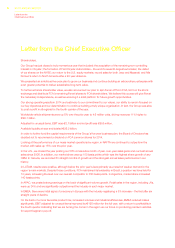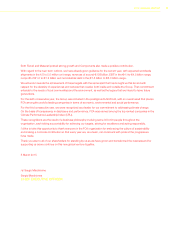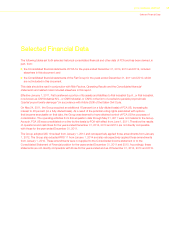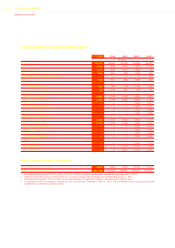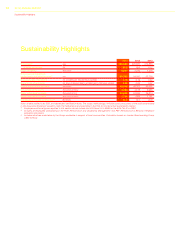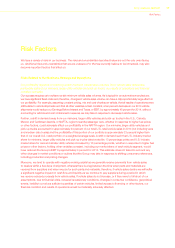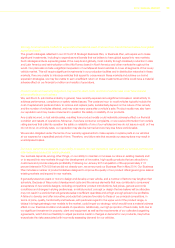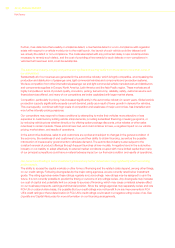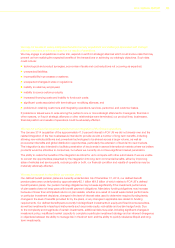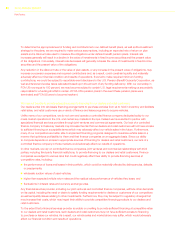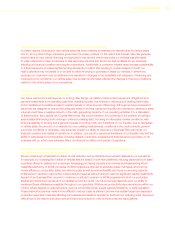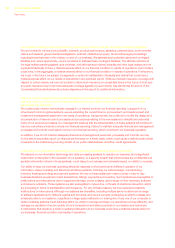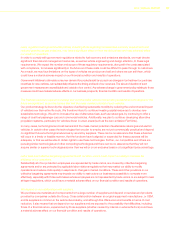Chrysler 2014 Annual Report Download - page 20
Download and view the complete annual report
Please find page 20 of the 2014 Chrysler annual report below. You can navigate through the pages in the report by either clicking on the pages listed below, or by using the keyword search tool below to find specific information within the annual report.
18 2014 | ANNUAL REPORT
Risk Factors
Our businesses are affected by global financial markets and general economic and other conditions over which we
have little or no control.
Our results of operations and financial position may be influenced by various macroeconomic factors—including
changes in gross domestic product, the level of consumer and business confidence, changes in interest rates for or
availability of consumer and business credit, energy prices, the cost of commodities or other raw materials, the rate of
unemployment and foreign currency exchange rates—within the various countries in which we operate.
Beginning in 2008, global financial markets have experienced severe disruptions, resulting in a material deterioration
of the global economy. The global economic recession in 2008 and 2009, which affected most regions and business
sectors, resulted in a sharp decline in demand for automobiles. Although more recently we have seen signs of
recovery in certain regions, the overall global economic outlook remains uncertain.
In Europe, in particular, despite measures taken by several governments and monetary authorities to provide financial
assistance to certain Eurozone countries and to avoid default on sovereign debt obligations, concerns persist regarding
the debt burden of several countries. These concerns, along with the significant fiscal adjustments carried out in several
countries, intended to manage actual or perceived sovereign credit risk, led to further pressure on economic growth and to
new periods of recession. Prior to a slight improvement in 2014, European automotive industry sales declined over several
years following a period in which sales were supported by government incentive schemes, particularly those designed
to promote sales of more fuel efficient and low emission vehicles. Prior to the global financial crisis, industry-wide sales of
passenger cars in Europe were 16 million units in 2007. In 2014, following six years of sales declines, sales in that region
rose 5 percent over 2013 to 13 million passenger cars. From 2011 to 2014, our market share of the European passenger
car market decreased from 7.0 percent to 5.8 percent, and we have reported losses and negative EBIT in each of the
past four years in the Europe, Middle East and Africa, or EMEA, segment. See Overview—Overview of Our Business
for a description of our reportable segments. These ongoing concerns could have a detrimental impact on the global
economic recovery, as well as on the financial condition of European financial institutions, which could result in greater
volatility, reduced liquidity, widening of credit spreads and lack of price transparency in credit markets. Widespread austerity
measures in many countries in which we operate could continue to adversely affect consumer confidence, purchasing
power and spending, which could adversely affect our financial condition and results of operations.
A majority of our revenues have been generated in the NAFTA segment, as vehicle sales in North America have experienced
significant growth from the low vehicle sales volumes in 2009-2010. However, this recovery may not be sustained or may
be limited to certain classes of vehicles. Since the recovery may be partially attributable to the pent-up demand and average
age of vehicles in North America following the extended economic downturn, there can be no assurances that continued
improvements in general economic conditions or employment levels will lead to additional increases in vehicle sales. As a
result, North America may experience limited growth or decline in vehicle sales in the future.
In addition, slower expansion or recessionary conditions are being experienced in major emerging countries, such
as China, Brazil and India. In addition to weaker export business, lower domestic demand has also led to a slowing
economy in these countries. These factors could adversely affect our financial condition and results of operations.
In general, the automotive sector has historically been subject to highly cyclical demand and tends to reflect the
overall performance of the economy, often amplifying the effects of economic trends. Given the difficulty in predicting
the magnitude and duration of economic cycles, there can be no assurances as to future trends in the demand for
products sold by us in any of the markets in which we operate.
In addition to slow economic growth or recession, other economic circumstances—such as increases in energy
prices and fluctuations in prices of raw materials or contractions in infrastructure spending—could have negative
consequences for the industry in which we operate and, together with the other factors referred to previously, could
have a material adverse effect on our financial condition and results of operations.


